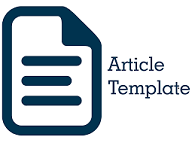Assessment for University Classroom Climate Improvement in Indonesia
Abstract
Improving classroom climate is an effort to enhance the quality of education on a micro scale that needs to be encouraged for lecturers in tertiary education. Several tertiary classroom climate instruments have been developed in English, for example the Colleges and Universities Classroom Environment Inventory (CUCEI), What is Happening in this Class (WIHIC), and have been translated into several languages. The University Classroom Climate Inventory (UCCI) is a classroom climate instrument which was developed and adapted in Bahasa Indonesia based on the English classroom climate instrument. To obtain information about a conducive classroom climate in Indonesia, it is necessary to assess the difference between actual and preferred classroom climate in some universities. The sample of the study was 400 students of Universitas Negeri Padang, Universitas Negeri Yogyakarta, Universitas Negeri Surabaya, Universitas Negeri Jakarta, Public Islamic University of Sutan Syarif Kasim Pekanbaru, and Public Islamic Institute of Kerinci, Indonesia. The result of the study shows that there was a significant difference between the actual and the preferred climate, which mean that there is a need to make better classroom climate in for these universities.
Full Text:
PDFReferences
Amelia, M. (2016). Pengaruh Adversity Quotion, Iklim Kelas dan Kebiasaan Belajar terhadap Prestasi Belajar Ekonomi Siswa Kelas XI.IS SMA Negeri di Kabupaten Tanah Datar. Journal of Economic and Economic Education, 4(1).
Aryani, A. N. D., & Alsa, A. (2016). Hubungan antara Iklim Kelas dengan Motivasi Belajar pada Mahasiswa. Jurnal of Psychology, 2(2).
Djigic, G., & Stojiljkovic, S. (2011). Classroom management styles, classroom climate and school achievement. Procedia-Social and Behavioral Sciences, 29, 819–828. https://doi.org/10.1016/j.sbspro.2011.11.310
Gascoigne, C. (2012). Toward an Understanding of the Relationship Between Classroom Climate and Performance in Postsecondary French: An Application of the Classroom Climate Inventory. Foreign Language Annals, 45(2), 193–202. https://doi.org/10.1111/j.1944-9720.2012.01186.x
Hadiyanto. (2016). Teori dan Pengembangan Iklim Kelas dan Iklim Sekolah. Kencana.
Hadiyanto, & Afriansyah, H. (2019). Improving Classroom Climate ofthe Course of Educational Administration and Supervision. Advance in Social Science, Education and Humanities Research, 335(ICESSHum), 350–355.
Hadiyanto, H., Syahril, S., Arwildayanto, & Sumar, W. T. (2019). Development of University Classroom Climate Inventory. Advance in Social Science, Education and Humanities Research, 295(ICETeP 2018), 346–350.
Hadiyanto, Jabar, C. S. A., & Kusumastuti, G. (2021). Pengembangan Alat Ukur dan Perbaikan Iklim Kelas Sekolah Menengah Atas.
Hadiyanto, & Kumaidi. (1998). Pengembangan dan Pemvalidasian Alat Ukur Iklim Kelas di Sekolah Lanjutan Tingkat Pertama.
Hadiyanto, & Pransiska, R. (2017). Kindergarten Climate in Padang. 169(Icece 2017), 128–130.
Hadiyanto, Syahril, Arwildayanto, & Sumar, W. T. (2018). Pengembagan dan Pemvalidasian Alat Ukur serta Perbaikan Iklim Kelas Perguruan Tinggi.
Husna, R., Buwono, S., & Matsum, J. H. (2013). Pengaruh Iklim Kelas dan Minat Belajar terhadap Hasil Belajar Siswa pada Pelajaran Ekonomi pada SMA (pp. 1–13). Universitas Tanjungpura.
Kocoska, J. (2010). The influence of the simulation strategy over the improvement of the classroom climate. Procedia - Social and Behavioral Sciences, 2(2), 3751–3754. https://doi.org/10.1016/j.sbspro.2010.03.583
L., A., & Brown, K. (2001). Percieved Applicant Fit: Distinguising between Recruiters’ Perceptions of Person-Job and Person-Organization Fit. Journal of African Elections, 7(1), 138–152. https://journals.co.za/content/eisa_jae/7/1/EJC32453
Mainhard, M. T., Brekelmans, M., & Wubbels, T. (2011). Coercive and supportive teacher behaviour: Within- and across-lesson associations with the classroom social climate. Learning and Instruction, 21(3), 345–354. https://doi.org/10.1016/j.learninstruc.2010.03.003
Pelu, H. (2019). The Students’ Attitude Towards English Classroom Environment of Madrasah Tsanawiyah Negeri Model Makassar 2018/2019. Andragogi: Jurnal Diklat Teknis Pendidikan Dan Keagamaan, 7(1), 146–160. https://doi.org/10.36052/andragogi.v7i1.83
Ryder, A. J., Reason, R. D., Mitchell, J. J., Gillon, K., Hemer, K. M., Ryder, A. J., Reason, R. D., Mitchell, J. J., Gillon, K., & Hemer, K. M. (2015). Journal of Diversity in Higher Education Climate for Learning and Students ’ Openness to Diversity and Challenge : A Critical Role for Faculty.
Saptiawati, & Hadiyanto. (2009). Upaya Meningkatkan Hasil Belajar Biologi Siswa melalui Perbaikan Iklim Kelas. Jurnal Manajemen Pendidikan, 5(2), 1–12.
Sari, J. R. (2013). Pengaruh Iklim Kelas dan Lingkungan Keluarga terhadap Motivasi Belajar Siswa Kelas X Jurusan Administrasi Perkantoran pada Mata Pelajaran Kompetensi Kejuruan Administrasi Perkantoran di SMK PGRI 2 Salatiga. Universitas Negeri Semarang.
Silalahi, J. (2008). Pengaruh Iklim Kelas terhadap Motivasi Belajar. Jurnal Pembelajaran, 30(02), 100–105.
Wahida, A. (2018). Pengaruh Person Environment Fit dan Organization Fit terhadap Kinerja Karyawan pada PT Bank Sulselbar Cabang Palopo. Jurnal Manajemen, 4(2), 48–58.
DOI: https://doi.org/10.24036/kolokium.v11i1.586
Refbacks
- There are currently no refbacks.

This work is licensed under a Creative Commons Attribution 4.0 International License.

